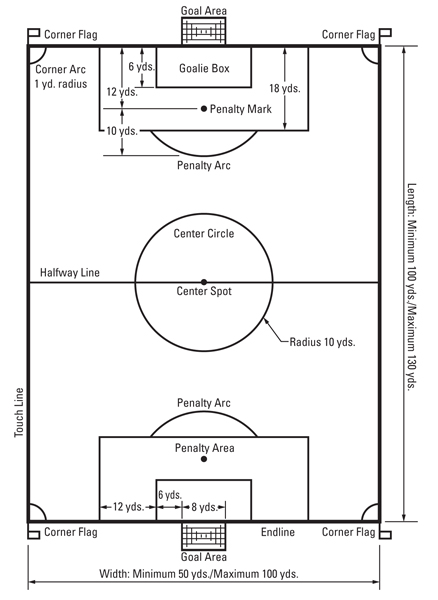Soccer is a game of 2 teams with 11 players each and field with a goal for each team. Other than that, it’s fast-paced with few breaks in the action, so as a player, you have to stay on your toes — or at least on your feet — throughout the game.
>
>
The Soccer Field
A basic soccer field is at least 100 yards long, 50 yards wide, and has a goal centered at both ends. But within that basic rectangle is the goalie’s box, the penalty line, the center circle, and, of course, the corners, without which corner kicks would just be kicks. The following figure shows the correct layout for a regulation soccer field:

>
>
>
Positions on a Soccer Team
Each soccer team has 11 players — 1 goalkeeper and 10 field players. Every player, whether playing an offensive or defensive position, works to help the team score goals — as many as possible. The following list explains the role of each position:
Goalkeeper: The keeper is the only player allowed to use his hands, and that activity is restricted to an 18-yard by 44-yard area called the penalty area. If a goalkeeper handles the ball outside of the box, she should be awarded a red card and the attacking team given a free kick from that spot.
Defenders: They play in front of the goalkeeper, and their primary duty is to stop the opposition from scoring or getting shots — quality and quantity. Their assignments and responsibilities can vary from man-to-man coverage or zone defense, in which they defend a particular area. Outside fullbacks play on the left and right wings and patrol the flanks and rarely move from their sides of the field. Central defenders play in the middle of the field and usually cover the opposition’s leading goal scorer or center forward(s).
Midfielders: These players are the link between the defense and attack. Midfielders must be the most physically fit players on the field because are expected to run the most in a game. They should be able to penetrate deep in enemy territory on attack and make the transition to defense when the opposition retains possession of the ball. Midfielders can specialize as an attacking player or defensive midfielder.
Forwards: Their primary job is to score goals or to create them for teammates. There are several types of forwards. Wings play on either the left or right side and usually run up and down the sides of the field. They can either take the ball into the penalty area for a shot or keep it on the flank and try to pass it to a teammate in the area. Center forwards play in the middle of the field, but they are allowed to wander if open space is there. A center forward, also known as a striker, should be a team’s leading goal scorer and most dangerous player up front.
>
>
>
Soccer Do’s and Don’ts
Soccer is a game of near-constant motion — unless you’re the keeper in which case you’re in a constant state of being ready to be in motion. In either case, make sure that your shoes fit well. They’re the most important part of your equipment.
The do’s and don’ts in the following table apply whether you’re playing a pick-up game or a league game:
| Do’s | Don’ts |
|---|---|
| Do learn to dribble with your head up. | Don’t be a ball hog. Pass to your teammates. |
| Do avoid touching the ball with your hands — unless you are the goalkeeper in the penalty area. It can result in a yellow or red card. | Don’t talk back to a referee. You can get a yellow card, and if it’s your second yellow, you will be ejected from the game. |
| Do find time to practice on your own or with teammates or kids on your block. | Don’t tackle from behind. You could get red-carded. |
| Do make sure that you are always in good physical shape. | Never come back from an injury too early. |
| Do show some sportsmanship after a match — win, lose, or draw — by shaking the hands of the opponent. |
Even if you’re sitting on the bench, stay alert and watch the play. You never know when the coach will call on you or a teammate will be injured.
>
>
dummies
Source:http://www.dummies.com/how-to/content/soccer-for-dummies-cheat-sheet.html
No comments:
Post a Comment